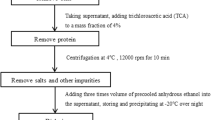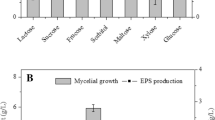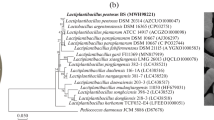Abstract
The free exopolysaccharide (f-EPS) produced by Streptococcus thermophilus is a natural texture modifier with health-promoting properties and has thus become one of the most interesting metabolites for researchers. The present work aimed to further understand the nutritional requirements for the growth of and the f-EPS production by S. thermophilus. The types and concentrations of compounds in the complete chemically defined medium were changed in turn to evaluate the effects of single nutrients on the growth of and f-EPS production by S. thermophilus 937. The results showed that cysteine, glutamine, histidine, methionine, tryptophan, tyrosine, leucine, isoleucine, and valine played an important role in maintaining the rapid and stable growth of S. thermophilus 937. S. thermophilus 937 also required calcium pantothenate, niacin, pyridoxine, riboflavin, and thiamine hydrochloride as essential nutrients for growth. Increases in the concentrations of lactose, glutamate, histidine, or isoleucine significantly increased the production of free exopolysaccharide by S. thermophilus 937, and when the lactose concentration increased to 20 g·L−1 and the concentration of the three-amino-acid combination increased to 15 mM, the f-EPS yield increased to a maximum of 35.34 μg·mL−1. This finding indicated that lactose and the 3 amino acids exert synergistic effects on the promotion of f-EPS production. In addition, lactose and the three amino acids have strain specific promoting effects on f-EPS production by S. thermophilus. This study provides a further understanding of the effects of nutrients on the biosynthesis of f-EPS by S. thermophilus.




Similar content being viewed by others
Data Availability
Not applicable.
Code Availability
Not applicable.
References
Cheng X, Huang L, Li KT (2019) Antioxidant activity changes of exopolysaccharides with different carbon sources from Lactobacillus plantarum LPC-1 and its metabolomic analysis. World J Microbiol Biotechnol 35(5):1–13. https://doi.org/10.1007/s11274-019-2645-6
Zhang S, Zhang LW (2012) Effect of exopolysaccharide producing lactic acid bacterial on the gelation and texture properties of yogurt. In: Chen R, Sun D, Sung W-P (eds) Advanced Materials Research. Trans Tech Publications, Switzerland, pp 890–893
Oluk AC, Güven M, Hayaloglu AA (2014) Proteolysis texture and microstructure of low-fat Tulum cheese affected by exopolysaccharide-producing cultures during ripening. Int J Food Sci Tech 49(2):435–443. https://doi.org/10.1111/ijfs.12320
Yang T, Wu K, Wang F, Liang X, Liu Q, Li G, Li Q (2014) Effect of exopolysaccharides from lactic acid bacteria on the texture and microstructure of buffalo yoghurt. Int Dairy J 34(2):252–256. https://doi.org/10.1016/j.idairyj.2013.08.007
Mizuno H, Tomotsune K, Islam MA, Funabashi R, Albarracin L, Ikeda-Ohtsubo W, Aso H, Takahashi H, Kimura K, Villena J, Sasaki Y, Kitazawa H (2020) Exopolysaccharides from Streptococcus thermophilus ST538 modulate the antiviral innate immune response in porcine intestinal epitheliocytes. Front Microbiol 11:894. https://doi.org/10.3389/fmicb.2020.00894
Minic Z, Marie C, Delorme C, Faurie JM, Mercier G, Ehrlich D, Renault P (2007) Control of EpsE, the phosphoglycosyltransferase initiating exopolysaccharide synthesis in Streptococcus thermophilus, by EpsD tyrosine kinase. J Bacteriol 189(4):1351–1357. https://doi.org/10.1128/JB.01122-06
Madhubasani GBL, Prasanna PHP, Chandrasekara A, Gunasekara DCS, Senadeera P, Chandramali DVP, Vidanarachchi JK (2019) Exopolysaccharide producing starter cultures positively influence on microbiological, physicochemical, and sensory properties of probiotic goats’ milk set-yoghurt. J Food Process Pres 44(3):1–8. https://doi.org/10.1111/jfpp.14361
Wang J, Wu T, Fang X, Yang Z (2019) Manufacture of low-fat Cheddar cheese by exopolysaccharide-producing Lactobacillus plantarum JLK0142 and its functional properties. J Dairy Sci 102(5):3825–3838. https://doi.org/10.3168/jds.2018-15154
Xu Y, Coda R, Holopainen-Mantila U, Laitila A, Katina K, Tenkanen M (2019) Impact of in situ produced exopolysaccharides on rheology and texture of fava bean protein concentrate. Food Res Int 115(1):191–199. https://doi.org/10.1016/j.foodres.2018.08.054
Shao L, Wu Z, Zhang H, Chen W, Ai L, Guo B (2014) Partial characterization and immunostimulatory activity of exopolysaccharides from Lactobacillus rhamnosus KF5. Carbohydr Polym 107(17):51–56. https://doi.org/10.1016/j.carbpol.2014.02.037
Sun N, Liu H, Liu S, Zhang X, Chen P, Li W, Xu X, Tian W (2018) Purification, preliminary structure and antitumor activity of exopolysaccharide produced by Streptococcus thermophilus CH9. Molecules. https://doi.org/10.3390/molecules23112898
Chaves AC, Fernandez M, Lerayer AL, Mierau I, Kleerebezem M, Hugenholtz J (2002) Metabolic engineering of acetaldehyde production by Streptococcus thermophilus. Appl Environ Microbiol 68(11):5656–5662. https://doi.org/10.1128/aem.68.11.5656-5662.2002
Li D, Li J, Zhao F, Wang G, Qin Q, Hao Y (2016) The influence of fermentation condition on production and molecular mass of EPS produced by Streptococcus thermophilus 05–34 in milk-based medium. Food Chem 197(Pt A):367–372. https://doi.org/10.1016/j.foodchem.2015.10.129
Degeest B, De Vuyst L (1999) Indication that the nitrogen source influences both amount and size of exopolysaccharides produced by Streptococcus thermophilus LY03 and modelling of the bacterial growth and exopolysaccharide production in a complex medium. Appl Environ Microbiol 65(7):2863–2870
Zisu B, Shah N (2003) Effects of pH, temperature, supplementation with whey protein concentrate, and adjunct cultures on the production of exopolysaccharides by Streptococcus thermophilus 1275. J Dairy Sci 86(11):3405–3415
Vaningelgem F, Zamfir M, Adriany T, De Vuyst L (2004) Fermentation conditions affecting the bacterial growth and exopolysaccharide production by Streptococcus thermophilus ST 111 in milk-based medium. J Appl Microbiol 97(6):1257–1273. https://doi.org/10.1111/j.1365-2672.2004.02418.x
Shene C, Canquil N, Bravo S, Rubilar M (2008) Production of the exopolysaccharides by Streptococcus thermophilus: effect of growth conditions on fermentation kinetics and intrinsic viscosity. Int J Food Microbiol 124(3):279–284. https://doi.org/10.1016/j.ijfoodmicro.2008.03.013
Cerning J, Bouillanne C, Landon M, Desmazeaud M (1992) Isolation and characterization of exopolysaccharides from slime-forming mesophilic lactic acid bacteria. J Dairy Sci 75(3):692–699
Pintado AIE, Ferreira JA, Pintado MME, Gomes AMP, Malcata FX, Coimbra MA (2020) Efficiency of purification methods on the recovery of exopolysaccharides from fermentation media. Carbohydr Polym 231(3):115703. https://doi.org/10.1016/j.carbpol.2019.115703
Torino MI, Hebert EM, Mozzi F, Font de Valdez G (2005) Growth and exopolysaccharide production by Lactobacillus helveticus ATCC 15807 in an adenine-supplemented chemically defined medium. J Appl Microbiol 99(5):1123–1129. https://doi.org/10.1111/j.1365-2672.2005.02701.x
Otto R, ten Brink B, Veldkamp H, Konings WN (1983) The relation between growth rate and electrochemical proton gradient of Streptococcus cremoris. FEMS Microbiol Lett 16(1):69–74
Letort C, Juillard V (2001) Development of a minimal chemically-defined medium for the exponential growth of Streptococcus thermophilus. J Appl Microbiol 91(6):1023–1029
Vuyst D, de Ven V (1998) Production by and isolation of exopolysaccharides from Streptococcus thermophilus grown in a milk medium and evidence for their growth-associated biosynthesis. J Appl Microbiol 84(6):1059–1068
Dubios M, Gilles K, Hamilton JK, Rebers PA, Smith F (1956) Colorimetric method for determination of sugar and related substances. Anal Chem 28:250–256
Grobben GJ, Chin-Joe I, Kitzen VA, Boels IC, Boer F, Sikkema J, Smith MR, de Bont JA (1998) Enhancement of exopolysaccharide production by Lactobacillus delbrueckii subsp. bulgaricus NCFB 2772 with a simplified defined medium. Appl Environ Microbiol 64(4):1333–1337
Wu Q, Shah NP (2018) Comparative mRNA-Seq analysis reveals the improved EPS production machinery in Streptococcus thermophilus ASCC 1275 during optimized milk fermentation. Front Microbiol 9(9):445. https://doi.org/10.3389/fmicb.2018.00445
Svensson M, Waak E, Svensson U, Rådström PJAEM (2005) Metabolically improved exopolysaccharide production by Streptococcus thermophilus and its influence on the rheological properties of fermented milk. App Environ Microbiol 71(10):6398–6400
Svensson M, Lohmeier-Vogel E, Waak E, Svensson U, Radstrom P (2007) Altered nucleotide sugar metabolism in Streptococcus thermophilus interferes with nitrogen metabolism. Int J Food Microbiol 113(2):195–200. https://doi.org/10.1016/j.ijfoodmicro.2006.06.032
Grobben GJ, Chin-Joe I, Kitzen VA, Boels IC, Bont JAMDJA, Microbiology E (1998) Enhancement of exopolysaccharide production by lactobacillus delbrueckii subsp. bulgaricus NCFB 2772 with a simplified defined medium. Appl Environ Microb 64(4):1333–1337
Wa Y, Zhang C, Sun G, Qu H, Chen D, Huang Y, Gu R (2022) Effect of amino acids on free exopolysaccharide biosynthesis by Streptococcus thermophilus 937 in chemically defined medium. J Dairy Sci 105(8):6460–6468. https://doi.org/10.3168/jds.2022-21814
Acknowledgements
The authors gratefully acknowledge Prof. Wenqiong Wang (Yangzhou University) for her suggestions on the results and lively discussions.
Funding
This work was funded by grants from the National Natural Science Foundation of China (No. 31972094) and City-school Cooperation to Build a Scientific and Technological Innovation Platform (No. YZ2020265). National Natural Science Foundation of China, 31972094, Ruixia Gu, City-school Cooperation to Build a Scientific and Technological Innovation Platform, YZ2020265, Ruixia Gu
Author information
Authors and Affiliations
Contributions
YW and CZ participated in the design of this study. The experiment was completed by Kuiyao Peng, who was assisted by YW. HQ, DC, and XC conducted the study and collected important background information. YW drafted the manuscript. All the authors read and approved the final manuscript.
Corresponding author
Ethics declarations
Conflicts of interest
The authors declare that they have no conflicts of interest associated with this work. We declare that we do not have any commercial or associative interest that represents a conflict of interest in connection with the work.
Ethical Approval
Not applicable.
Consent to Participate
Not applicable.
Consent for Publication
Not applicable.
Additional information
Publisher's Note
Springer Nature remains neutral with regard to jurisdictional claims in published maps and institutional affiliations.
Rights and permissions
Springer Nature or its licensor (e.g. a society or other partner) holds exclusive rights to this article under a publishing agreement with the author(s) or other rightsholder(s); author self-archiving of the accepted manuscript version of this article is solely governed by the terms of such publishing agreement and applicable law.
About this article
Cite this article
Wa, Y., Zhao, X., Peng, K. et al. Effects of Nutrients on the Growth of and Free Exopolysaccharide Biosynthesis by Streptococcus thermophilus 937 in a Chemically Defined Medium. Curr Microbiol 80, 331 (2023). https://doi.org/10.1007/s00284-023-03421-x
Received:
Accepted:
Published:
DOI: https://doi.org/10.1007/s00284-023-03421-x




